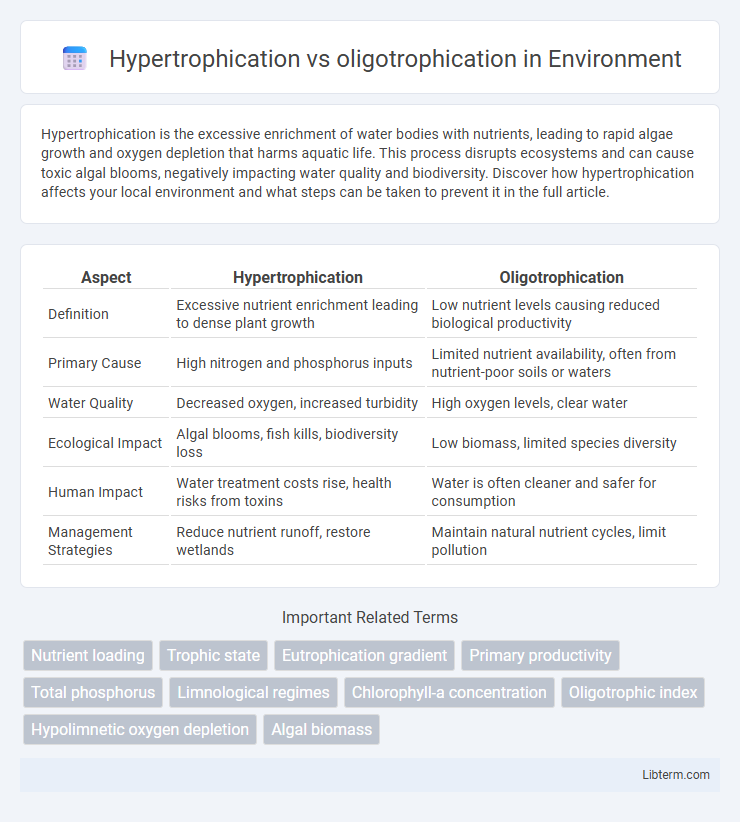Hypertrophication is the excessive enrichment of water bodies with nutrients, leading to rapid algae growth and oxygen depletion that harms aquatic life. This process disrupts ecosystems and can cause toxic algal blooms, negatively impacting water quality and biodiversity. Discover how hypertrophication affects your local environment and what steps can be taken to prevent it in the full article.
Table of Comparison
| Aspect | Hypertrophication | Oligotrophication |
|---|---|---|
| Definition | Excessive nutrient enrichment leading to dense plant growth | Low nutrient levels causing reduced biological productivity |
| Primary Cause | High nitrogen and phosphorus inputs | Limited nutrient availability, often from nutrient-poor soils or waters |
| Water Quality | Decreased oxygen, increased turbidity | High oxygen levels, clear water |
| Ecological Impact | Algal blooms, fish kills, biodiversity loss | Low biomass, limited species diversity |
| Human Impact | Water treatment costs rise, health risks from toxins | Water is often cleaner and safer for consumption |
| Management Strategies | Reduce nutrient runoff, restore wetlands | Maintain natural nutrient cycles, limit pollution |
Introduction to Hypertrophication and Oligotrophication
Hypertrophication refers to the excessive enrichment of water bodies with nutrients, primarily nitrogen and phosphorus, leading to dense algal blooms and decreased oxygen levels. Oligotrophication describes the process where nutrient levels in aquatic ecosystems decline, resulting in clearer water with low biological productivity. Understanding these contrasting ecological states is crucial for managing freshwater resources and maintaining aquatic biodiversity.
Defining Hypertrophication: Causes and Processes
Hypertrophication is a process characterized by excessive nutrient enrichment, primarily nitrogen and phosphorus, leading to dense algal blooms and oxygen depletion in aquatic ecosystems. Major causes include agricultural runoff, sewage discharge, and industrial effluents, which introduce high nutrient loads into water bodies. This nutrient overload triggers eutrophication, causing harmful ecological effects such as hypoxia, loss of biodiversity, and altered aquatic food webs.
Understanding Oligotrophication: Mechanisms and Drivers
Oligotrophication refers to the process where aquatic ecosystems experience a decline in nutrient levels, particularly nitrogen and phosphorus, leading to reduced primary productivity and clearer water conditions. Key mechanisms driving oligotrophication include natural sedimentation, nutrient sequestration by aquatic plants, and human activities such as watershed management and pollution control that limit nutrient inputs. Understanding these drivers is crucial for preserving biodiversity and water quality in oligotrophic lakes and reservoirs.
Key Differences Between Hypertrophication and Oligotrophication
Hypertrophication refers to the excessive enrichment of water bodies with nutrients, leading to dense plant growth and oxygen depletion, whereas oligotrophication describes the process of nutrient depletion resulting in reduced productivity and clearer water. Key differences include nutrient levels, where hypertrophication involves high concentrations of nitrogen and phosphorus, while oligotrophication is characterized by low nutrient availability. Oxygen dynamics also differ; hypertrophication often causes hypoxic conditions due to decomposing biomass, whereas oligotrophic waters maintain higher oxygen levels due to limited organic matter.
Ecological Impacts: Hypertrophic vs Oligotrophic Waters
Hypertrophic waters, characterized by excessive nutrient loads, lead to harmful algal blooms, oxygen depletion, and loss of biodiversity, severely impacting aquatic ecosystems. Oligotrophic waters, with low nutrient concentrations, support clear water conditions, high oxygen levels, and diverse fish populations but have limited primary productivity. The contrast in nutrient availability between hypertrophic and oligotrophic systems drives distinct ecological dynamics, affecting species composition, water quality, and ecosystem services.
Human Activities Influencing Nutrient Dynamics
Human activities significantly influence nutrient dynamics leading to hypertrophication or oligotrophication in aquatic ecosystems. Excessive use of fertilizers, wastewater discharge, and agricultural runoff introduce high levels of nitrogen and phosphorus, promoting hypertrophication characterized by algal blooms and oxygen depletion. Conversely, water extraction, deforestation, and land use changes reduce nutrient inflows, driving oligotrophication and resulting in decreased primary productivity and biodiversity loss.
Water Quality Indicators: Measuring Trophic States
Hypertrophication is characterized by excessive nutrient enrichment, leading to algal blooms, decreased oxygen levels, and poor water quality, often measured by elevated concentrations of nitrogen, phosphorus, chlorophyll-a, and low Secchi disk transparency. Oligotrophication indicates nutrient depletion resulting in clear waters, low chlorophyll-a, high dissolved oxygen, and increased water clarity, reflecting pristine or nutrient-poor conditions. Key trophic state indices such as Carlson's Trophic State Index (TSI) integrate these indicators to quantify the nutrient status and overall health of aquatic ecosystems.
Management Strategies for Controlling Nutrient Levels
Effective management strategies for controlling nutrient levels in aquatic ecosystems include reducing nutrient inputs through agricultural best practices such as precision fertilization and buffer zones to prevent hypertrophication. Implementing aeration and biomanipulation techniques can help restore oligotrophic conditions by enhancing oxygen levels and promoting balanced aquatic communities. Monitoring nutrient concentrations and enforcing regulations on wastewater discharge are essential to maintain ecosystem health and prevent excessive eutrophication.
Case Studies: Global Examples of Hypertrophic and Oligotrophic Systems
Hypertrophication is exemplified by the Chesapeake Bay in the United States, where excessive nutrient runoff has caused algal blooms and hypoxic conditions, severely impacting aquatic biodiversity. Oligotrophication is observed in Lake Tahoe, USA, characterized by low nutrient levels supporting clear waters and diverse, oxygen-rich habitats. Global studies highlight how nutrient imbalances drive contrasting ecosystem functions, with hypertrophic systems facing eutrophication stress and oligotrophic systems maintaining ecological stability through limited nutrient inputs.
Future Perspectives on Aquatic Nutrient Management
Future perspectives on aquatic nutrient management emphasize balancing hypertrophication and oligotrophication to sustain ecosystem health. Innovations in nutrient bioavailability monitoring and precision nutrient input control aim to prevent excessive eutrophication while avoiding nutrient depletion that causes oligotrophic conditions. Integrating advanced remote sensing technologies with adaptive management frameworks fosters resilient aquatic environments by optimizing nutrient levels for biodiversity and water quality.
Hypertrophication Infographic

 libterm.com
libterm.com